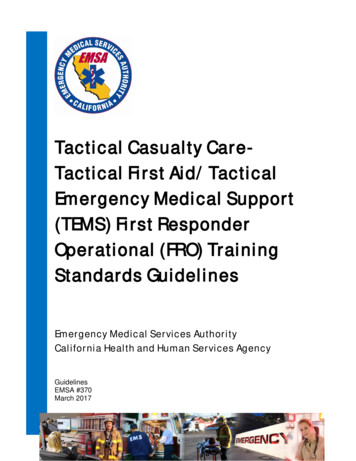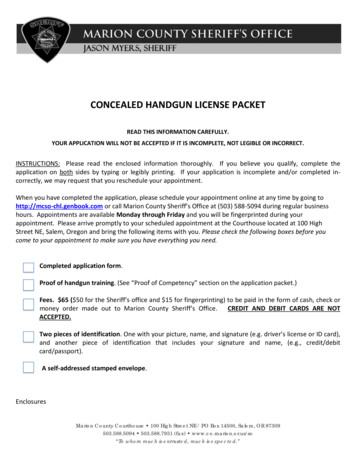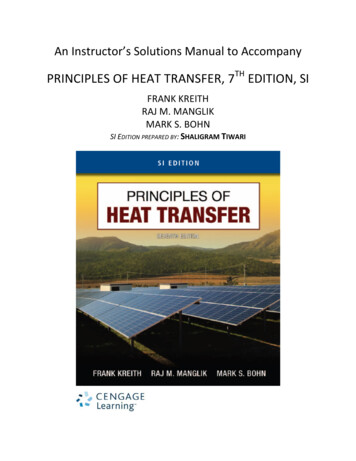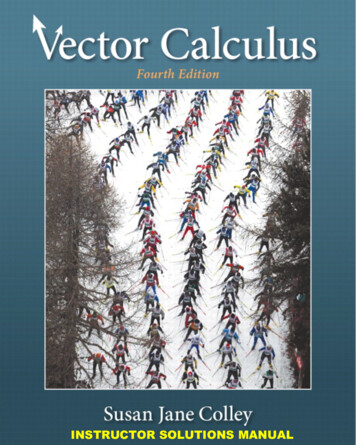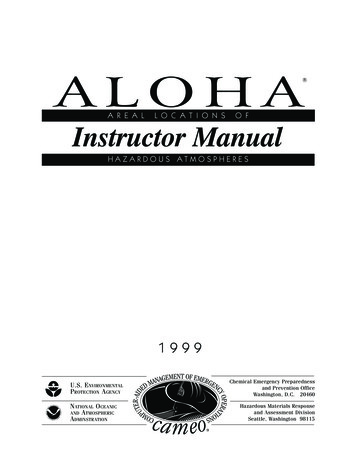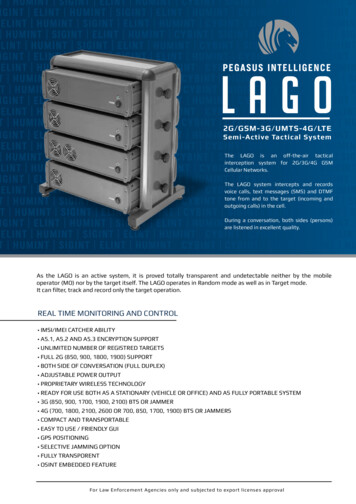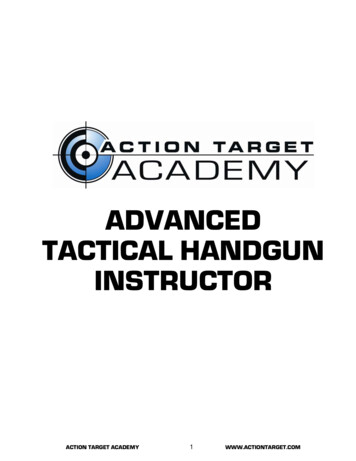
Transcription
ADVANCEDTACTICAL HANDGUNINSTRUCTORACTION TARGET ACADEMY1WWW.ACTIONTARGET.COM
TABLE OF CONTENTSPROGRAM GOALS . 3AND OBJECTIVES. 3COURSE OUTLINE. 5FIREARMS SAFETY RULES . 7INSTRUCTOR DEVELOPMENT. 8COACHING SKILL DEVELOPMENT. 26TRAINING CONSIDERATIONS . 32COURSE DEVELOPMENT . 40PHYSICAL CONDITIONING FOR LAW ENFORCEMENT OFFICERS. 42RANGE COMMANDS . 47TEACHING BASIC SHOOTING TECHNIQUES . 53WHY SHOOTERS FAIL . 59SHOOTING DRILLS . 62AMMUNITION . 63GETTING THE RIGHT TWIST . 89COVERT CARRY AND PLAIN CLOTHES OPERATION. 91TACTICAL HANDGUN. 107TRAINING CONSIDERATIONS . 109RANGE EXERCISES. 116REDUCED LIGHT TECHNIQUES . 119INTERACTIVE USE OF FORCE TRAINING . 138COVERT CARRY INSTRUCTOR PRACTICAL EXAM . 145FIREARMS PREVENTATIVE MAINTENANCE GUIDE . 149ACTION TARGET ACADEMY2WWW.ACTIONTARGET.COM
PROGRAM GOALSAND OBJECTIVESProgram GoalTo elevate the Firearms Instructor and Range Master above the level previously certified by expanding theirknowledge base, operational skills and instructional capability in the areas of officer survival, concealed / covert carry,and range operations. This program will provide both technical and tactical training techniques that are based onduty specific requirements. Therefore, the overall program goal is to develop an Instructor who is capable of teachingboth the science of effective handgun shooting at close quarters and the art of concealed carry to their personnel.This will be accomplished with a combination of both classroom and range activity.Program ObjectivesUpon successful completion of this program, the participant will know:1.The influences that civil litigation, case law, and agency policy have on training and the application of force.2.Instructional methods specific to long term retention of material.3.How to conduct safe, effective training.4.Adult learning theory as it applies to public speaking, classroom presentation, and motor skill development.5.How to develop course of fire, tactics and techniques specific to concealed carry situations.6.Coaching principles and effective on – line instruction techniques.7.Why shooters fail and what to do about it.8.Understanding standard operating procedures (SOPs) for live fire range training.9.Understanding advantages and disadvantages of concealed carry options.10. Backup options.11. Advancing the fundamentals of marksmanship for concealed carry.12. Firearms safety in the office, home, and vehicle.13. Concealed carry handguns - advantages and disadvantages.14. Holsters and carry systems - advantages and disadvantages.15. Equipment selection considerations.16. Optional carry positions.17. Optional equipment (flashlights, impact weapons).18. Safe loading and unloading for concealed carry.19. One-handed and two-handed drawing and re-holstering techniques.ACTION TARGET ACADEMY3WWW.ACTIONTARGET.COM
20. CQB techniques for violent encounters.21. Sighted and unsighted shooting techniques.22. Dominant and support hand shooting techniques.23. Justification of multiple shot techniques.24. Identification and engagement of multiple opponents.25. Shooting while moving.26. Engaging moving threats.27. Identification and utilization of cover.28. Tactics and techniques in and around vehicles.29. Diminished light techniques.30. Inspection and maintenance.31. Interactive force-on-force training.The student will be evaluated by the following methods:1.Oral presentation.2.Lesson plan development.3.Practical examination.4.Live fire courses.5.Interactive force-on-force.6.Overall safe weapons handling.ACTION TARGET ACADEMY4WWW.ACTIONTARGET.COM
COURSE OUTLINEDAY 1: A.M.1. Program introductiona. Program goals and objectivesb. Staff and student introductionsc. Safety rules, liability waiverd. How students will be evaluatede. Manual overviewf. Firearms safety – office, home, vehicle2. Instructor developmenta. Principles of adult learningb. Outline and usec. Lesson plan developmentd. Communication skillse. Public speakingf. Course developmentDAY 1: P.M.1.Instructor development (continued)g. Coaching skill developmenth. Range commandsi. Objective of on-line instructionj. Working with problem shootersk. Function check of handgunsl. Live fire exercisesi. One hole drill / sighted versus unsighted shootingm. Review of practical examDAY 2: A.M.2.3.4.Review of coaching techniquesa. Support equipmentUnderstanding standard operating proceduresCQB techniques for violent encountersDAY 2: P.M.5.6.Range operations and setupReview of practical examinationDAY 3: A.M.7. Advanced tactics and techniquesa. Movementb. Seated8. Utilization of cover9. Multiple threats / targetsACTION TARGET ACADEMY5WWW.ACTIONTARGET.COM
DAY 3: P.M.10. Introduction to diminished light techniques and tactics (classroom)11. Range:a. Flashlight techniquesb. Tactical light techniques12. Review of Practical ExaminationDAY 4: A.M.13. Range:a. Shooting in, around, and from vehiclesb. Vehicles, cover? and concealmentDAY 4: P.M.14. ASIS – 3000 judgment shooting / prep for classroom presentationsDAY 5: A.M.15. Classroom presentations and feedbackDAY 5: P.M.16. Practical Exam coach / student17. Final qualification course18. Closing, critiques and graduationACTION TARGET ACADEMY6WWW.ACTIONTARGET.COM
FIREARMS SAFETY RULESA. CARDINAL RULES OF FIREARMS SAFETY:1. Treat all firearms as though they are loaded.2. Point the muzzle in a safe direction at all times.3. Keep your finger outside the trigger guard until you are on target and have decided to fire.4. Be sure of your target and what is beyond it.B. SPECIFIC RULES:1. Do you have any physical disability, limitation, illness or other condition that would affect your ability toparticipate safely in any aspect of this program? Yes No (Initials)2. Are you under the influence of any prescription/non prescription drug or alcohol that would influence yoursafe participation in any aspect of this program? Yes No (Initials)3. Ear protection, wrap around eye protection and hat with brim are required to be worn at all times whileshooting on the range. This applies to shooters, instructors and observers.4. When you pick up a firearm, keep your finger off of the trigger, point the muzzle in a safe direction, open theaction and check both visually and physically to see that it is unloaded.5. Check a second time.6. Never give or take a firearm from anyone unless the action is open for inspection.7. Load/reload/unload only after position is taken at the firing point and on command.8. Keep the firearm pointed down range at all times.9. Never draw a handgun from the holster on the range unless instructed.10. Never draw/re-holster with your finger in the trigger guard or on the trigger.11. NEVER holster a cocked weapon (cocked and locked weapons excluded). (Initials)12. Always wash hands and face after leaving the range and shower & change clothing at the end of a shootingday to reduce the possibility of lead contamination.13. Never go forward of the firing line unless instructed.14. Never step back from the firing line unless your handgun is safely holstered, and the instructor directs you todo so.15. While on the firing line, never bend over to retrieve dropped articles until instructed to do so.16. No talking on the firing line except by, or with an instructor.17. No eating, chewing tobacco or smoking on the firing line.18. Pay strict attention to the instructor and the tower.19. Never anticipate a command.20. Never permit the muzzle of a firearm to touch the ground.21. Conduct a proper safety check of the weapon before and after a training session.22. Never dry fire on the range unless instructed to do so.23. All safety precautions must be adhered to and will be enforced. .24. You are expected to use good judgment, and to refrain from attempting any exercise, which you may not beable to perform safely, based upon your own ability, equipment, prior training or physical condition.(Initials)25. Eye protection MUST be worn when cleaning any firearm. (Initials)26. Females who are pregnant or breast feeding should not participate in firearms training or be allowed on therange.27. REMEMBER: Everyone has the responsibility for range safety.ACTION TARGET ACADEMY7WWW.ACTIONTARGET.COM
INSTRUCTOR DEVELOPMENTACTION TARGET ACADEMY8WWW.ACTIONTARGET.COM
ACTION TARGET ACADEMY9WWW.ACTIONTARGET.COM
ACTION TARGET ACADEMY10WWW.ACTIONTARGET.COM
ACTION TARGET ACADEMY11WWW.ACTIONTARGET.COM
ACTION TARGET ACADEMY12WWW.ACTIONTARGET.COM
ACTION TARGET ACADEMY13WWW.ACTIONTARGET.COM
ACTION TARGET ACADEMY14WWW.ACTIONTARGET.COM
ACTION TARGET ACADEMY15WWW.ACTIONTARGET.COM
ACTION TARGET ACADEMY16WWW.ACTIONTARGET.COM
ACTION TARGET ACADEMY17WWW.ACTIONTARGET.COM
ACTION TARGET ACADEMY18WWW.ACTIONTARGET.COM
ACTION TARGET ACADEMY19WWW.ACTIONTARGET.COM
ACTION TARGET ACADEMY20WWW.ACTIONTARGET.COM
ACTION TARGET ACADEMY21WWW.ACTIONTARGET.COM
ACTION TARGET ACADEMY22WWW.ACTIONTARGET.COM
ACTION TARGET ACADEMY23WWW.ACTIONTARGET.COM
ACTION TARGET ACADEMY24WWW.ACTIONTARGET.COM
ACTION TARGET ACADEMY25WWW.ACTIONTARGET.COM
COACHING SKILLDEVELOPMENTI.OBJECTIVES OF ON-LINE INSTRUCTIONThe prime objectives for an instructor while coaching the line are two-fold. First, the instructor must be thecomparative model for all skills and techniques to be developed in order to provide the student with a suitablevisual learning experience.It is necessary that the instructor demonstrate the skill at no more than one-half speed or power to reduce theincidence of student error associated with moving too fast. Additionally, the instructor must be able to separateeach skill into three component parts - beginning, middle and end - to demonstrate each motor skills stage andreinforce expected student behavior.Secondly, the instructor must provide immediate individual feedback on performance to those being coached. Acritique or evaluation that is delayed has limited training value. Further, constant criticism or attempting toindicate to the student everything that was in error all at once is counterproductive to student success. When theinstructor/student ratio of 1 to 5 is maintained, an ample opportunity for individual growth is presented for thestudent.The instructor must take an active approach in coaching in order to prevent the habituation of impropertechnique. This requires that the coach correct for deficiencies at the time they are observed rather thanremanding the student to a remedial training program for adjustment. In all but extreme cases, remedial trainingthat separates the student from the main body stereo types the student as one who cannot be depended upon ina shooting situation. However wrong this is, it sets up individual failure.For the instructor to assume an active role, the instructor must:A.Completely understand the skill or technique being presented to be able to separate it into its threecomponent parts for proper instruction.B. Be able to relate the technique to the overall structure of training to demonstrate a building block approachfor learning and student success.C. Become a focused observer to single out the components of the technique demonstrated by the student.D. Understand the principles of developing motor skills by undertaking a basic study of anatomy and physiology.E. Know the standard for each skill or technique presented for instruction, coaching and evaluation.There may be circumstances which will require that a deficient student be remanded to a scheduled remedialtraining program. If this is necessary, the instructor/student v ratio should be one to one. This type of instructionshould be provided within 72 hours of program failure in order to build upon all successes noted in the earlier "program. It is important that the instructor return to the basics for this type of instruction as this is likely wherethe fault lies.Remedial training programs should not be rehearsals for qualification courses or performance evaluations. Rather,they should be fully structured training programs with specific objectives to reduce the incidence of student error.Remedial programs that are copies of assessments to be performed do a major disservice to the student, and theagency.II. EVALUATION of PHYSICAL SKILLSIn the verbal communication section of this manual, reference was made to the practice of a prepared statementevery day, a minimum of five times. This continued practice "educates" the palate and polishes yourcommunicative style. So it is with physical skills.The threshold of performance for developing any motor skill is a minimum of 25 repetitions. At the static level ofdevelopment, this number of slow-motion repetitions anchors the skill or technique not only in the mind of thestudent but also in the muscle memory of the affected muscle groups. Additional repetitions reinforce the neuralconnection pathway between the motor center of the brain and the last muscle group to be activated.ACTION TARGET ACADEMY26WWW.ACTIONTARGET.COM
Certainly it is important for your students to do their repetitions in numbers exceeding 25 as time allows. It ismore important, however, for you to commit to daily practice of those techniques you teach in order to become,intimately aware of the technique and its physical requirements. You should video tape your practice sessionsand, just like professional teams viewing game films, critique your performance and study ways to improve.The video camera should also be used to video tape classes in motor skill development. Time needs to beallocated by you to the study of these films, as this study is your practice time in developing your coaching skills.If you do not study your students, your capacity as a coach is severely diminished.Three things thus become apparent:A. Physical skills that you teach should be practiced every day. Set aside enough time to perform 25 repetitionsof each skill. Log your practice sessions and time expended.B. Viewing your personal "game films" should be a weekly occurrence to structure your practice sessions forachievement.C. Viewing film footage of your students performing what they have been taught should be done frequently. Fornew instructors, viewing raw footage (ex. a two minute tape of the same student performing a specific task)should be studied five times per day. As you become more skilled in your powers of observation, the numberand frequency of these sessions will diminish but should never be eliminated.When evaluating the physical skills of others, you will find it helpful to carry a pocket recorder to note yourobservations. This allows your visual focus to remain on the student as you record your thoughts. Certainly a notepad will work in lieu of a recorder, but the down side is that you will spend more time looking at the pad than atthe student.Your range set-up will have a major impact on your ability to evaluate individual physical skills. Barriers such asindoor shooting booths or extreme distances between shooters outdoors (so no one gets hit by flying brass!?)create both observation and coaching problems for the instructor. When performing static drills, the maximumdistance between each of your five students should be no more than 5 feet shoulder to shoulder. This allows youto see everyone and more importantly, respond to a problem immediately.When you watch, you should walk the line. A slow paced walk, pausing when necessary, should continue fromone end of your section of the line to the other at a distance of 3 feet from the backs of the students. This willallow you to study each student from both their open (support) and closed (dominant) sides. Additionally, itcauses you to focus more on each student as opposed to standing in a fixed position behind the line watching thetargets down range.There will be times when you must work with an individual on the line. Where possible, have the range masterdelay the start of the next sequence until you have had the time to provide whatever corrective information wasnecessary. Under no circumstances should you delay line operations longer than 20 seconds.Remember, that when you work with an individual you should focus on singular problems and correct them oneat a time rather than trying to do everything at once. When you coach an individual, you need to be mindful thatyou have other individuals you are responsible for on the line. Show them the same courtesy in attention that youwould with any student you stop to help.When you are coaching a specific individual, there are three locations that you can work from. It is recommendedthat you use all three. The positions are:A. To the outside rear of the student's dominant shoulder and no farther away than 2 feet. Here, you can mirrorthe student's activity and remain close enough to make immediate physical correction.B. On line with the student, to the dominant side and facing, 1 foot to 2 feet away. This position gives you alateral view and is the optimum position to determine weapon/eye alignment and dominant arm skills.C. On line with the student, to the support side and facing, 1 foot to 2 feet away. This position also provides alateral view and is the optimum position to observe trigger control and support arm skills.Safety is the most important factor when you use any of these positions. The lateral positions may cause yourback to be laterally facing another shooter. Use the lateral coaching positions only during dry fire activities,ACTION TARGET ACADEMY27WWW.ACTIONTARGET.COM
staying behind the line during live fire.Unless it is necessary to physically stop a student from turning around, always make verbal contact with thestudent BEFORE making physical contact. Make sure that you do this from a position that allows you to stop thestudent if they are startled by you and start to turn around. The best position for this is the outside rear of thestudent's dominant shoulder.Finally, you must be sensitive to gender issues when coaching physical skills. Since this type of training
ACTION TARGET ACADEMY 7 WWW.ACTIONTARGET.COM FIREARMS SAFETY RULES A. CARDINAL RULES OF FIREARMS SAFETY: 1. Treat all firearms as though they are loaded. 2. Point the muzzle in a safe direction at all times. 3. Keep your finger outside the trigger guard until you are on target and have decided to fire. 4. Be sure of your target and what is .
